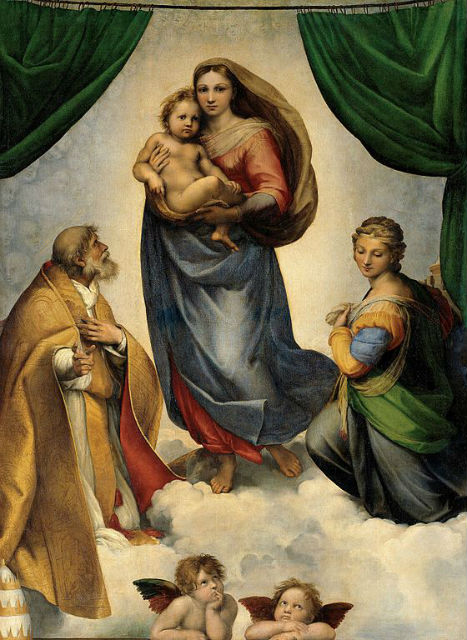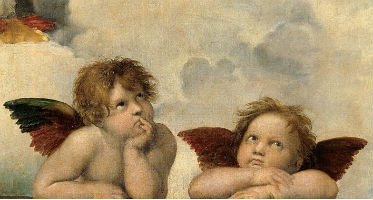
RICHMOND, Va. (AP) – It’s the sort of story that tickles curiosities and generates more questions than answers: A rare centuries-old print — an engraved copy — of a famous painting by an Italian Renaissance master hangs in a small church in rural Virginia and goes unnoticed for who knows how long until a random stranger happens upon it and sees it for what it is.
Richmond resident Federico Colagrande attended a funeral in November 2015 at Gilboa Christian Church, a quaint circa 1849 building located on U.S. 33 in Louisa County.
He and his girlfriend, Annette Bronson, filed into the church’s fellowship hall after the service along with the rest of the funeral attendees, but they didn’t stop there.
“Extreme churching” is what they call their love of exploring churches, and on that day, he and Bronson asked for permission to tour the rest of Gilboa. Church officials obliged.
As Colagrande left the sanctuary, he came face to face with an aging framed print hanging in a hallway. It featured the Virgin Mary holding the baby Jesus; she walked on clouds and was flanked by a man and a woman, and at her feet were two cherubs.
At the bottom of the print, he read the words: “LA MADONNA DI S. SISTO DI RAFAELLO.”
“My eyes were captured by this print,” Colagrande recently recalled as he detailed the events of that day in 2015. Colagrande was born and raised in Piacenza, Italy, and he studied Latin and ancient Greek. Although art history isn’t his day job, he’s an avid researcher and collector, particularly when it comes to Italian art.
Upon closer inspection, Colagrande recognized that he could be in the presence of what he called a “Müller Madonna.”
(A brief history lesson: the Madonna di San Sisto is a Raphael oil painting commissioned around 1512 for the altar of San Sisto, a church in Piacenza. The painting was commissioned by Pope Julius II in honor of his late uncle, Pope Sixtus IV. The people represented in the painting are the Virgin Mary and baby Jesus, along with two saints, Sixtus and Barbara. There are also two cherubs — familiar icons that now grace everything from U.S. postage stamps to the background motif on bank-issued checks.
The original painting was sold to a ruler in Saxony in 1754. Today, it resides in a gallery in Dresden, Germany. From the original, however, Friedrich Müller created the plates from which prints were made, and only a handful of those prints exist today.)
To further support his belief that the print was indeed a “Müller Madonna,” Colagrande said, there was a coat of arms for the King of Saxony, for whom the print was intended and dedicated, as indicated in Latin and Italian. Müller’s name was also present.
Then, on the back of the print was the stamp of a noted 18th- and 19th-century art dealer — Goupil’s — with an address of Fifth Avenue in New York. There was also a mysterious red tag hanging on the back with a name: “Mrs. T.G. Brown.”
Simply put, Colagrande was stunned. Church officials were perplexed.
“It’s always been in the hallway,” said church elder Joe Leslie, adding that the finding sparked conversations within the church membership about its origins, but no one could identify where the print came from or how long it had been there. “We were all used to it (and) had never thought about it. I don’t think I’d ever even noticed there was Italian writing on the bottom of it.”
Colagrande embarked on his own research to learn more about the print, including a trip to Piacenza in which he met with clergy at San Sisto.
He presented his findings to the Louisa church congregation in April 2016.
“When this all happened, we were anxiously awaiting to hear the backstory,” Leslie said. “It was really neat to find out, (especially when) you find out anything about a history of a church that you think you know quite a bit about.”
Colagrande said the prints can be found in museums in the U.S. and Europe, including the Metropolitan Museum of Art in New York, the Museum of Fine Arts in Boston and the British Museum in London, and this would be the sixth print known to be in existence.
Museum officials at The Met in New York, as well as the MFA in Boston, confirm that they have Madonna di San Sisto prints, though they declined to comment on their respective values or any other details about the print found at Gilboa. Neither museum has the prints currently on public display.
Colagrande acknowledges he has no stake in the painting, though, at the request of church leaders, he has since helped them find appraisers. Church officials won’t share the print’s appraised value, and, for now, have no plans to seek additional information about the print from art professionals. But no matter the dollar amount, it’s a piece worthy of a museum, Colagrande said. That places such as The Met and British Museum have these prints tells a lot, he added.
Within the church, “it was an old thing,” Colagrande said. But “it’s an amazing beautiful print.”
He added, “This is something precious.”
___
By HOLLY PRESTIDGE, Richmond Times-Dispatch
Copyright 2018 Associated Press. All rights reserved. This material may not be published, broadcast, rewritten, or redistributed.
AP-WF-03-07-18 1638GMT



